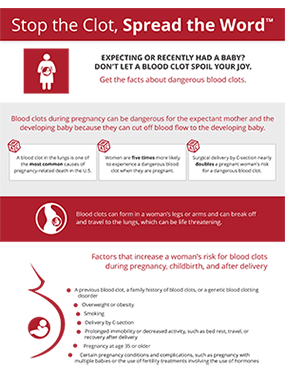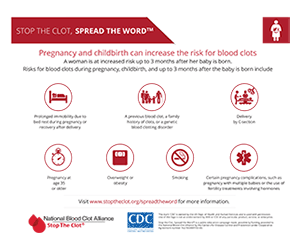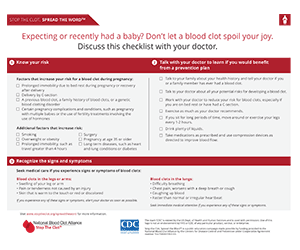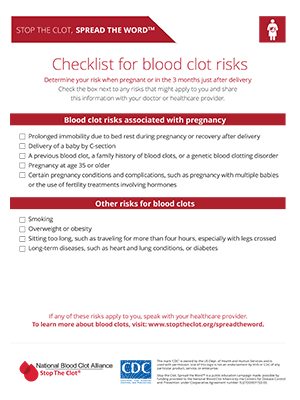Venous Thromboembolism (Blood Clots) and Pregnancy
Pregnant? Recently had a baby? You are at increased risk for developing a blood clot. But the good news is, blood clots may be preventable and treated if discovered early.

Expecting or recently had a baby? Don’t let a blood clot spoil your joy.
While everyone is at risk for developing a blood clot (also called venous thromboembolism or VTE), pregnancy increases that risk fivefold. Learn other interesting facts about blood clots.
Why do pregnant women have a higher risk of developing a blood clot?
Women are especially at risk for blood clots during pregnancy, childbirth, and the three-month period after delivery. Here’s why:
- During pregnancy, a woman’s blood clots more easily to lessen blood loss during labor and delivery.
- Pregnant women may also experience less blood flow to the legs later in pregnancy because the blood vessels around the pelvis are pressed upon by the growing baby.
Several other factors may also increase a pregnant woman’s risk for a blood clot:
- A family or personal history of blood clots or a blood clotting disorder
- Delivery by C-section
- Prolonged immobility (not moving a lot), such as during bed rest or recovery after delivery
- Complications of pregnancy and childbirth
- Certain long-term medical conditions, such as heart or lung conditions, or diabetes
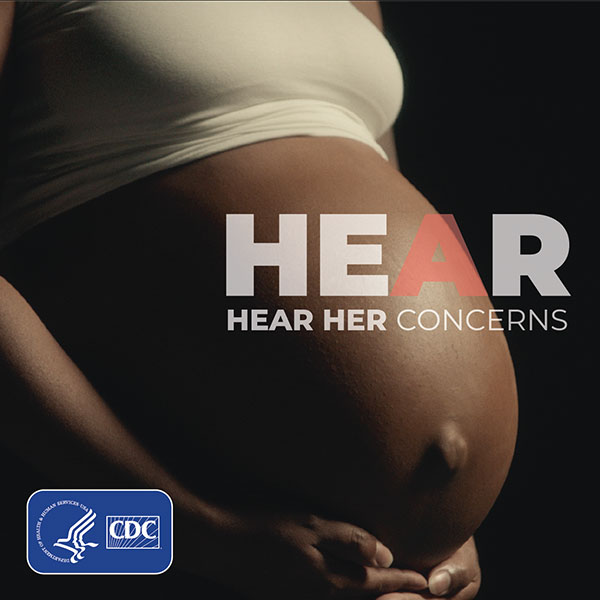
Too many women die from pregnancy-related complications and many more experience severe-pregnancy-related complications. Knowing the signs and symptoms of a blood clot is important to protect yourself and your baby during pregnancy and after delivery. Visit CDC’s new Hear Her campaign website to learn the warning signs to watch for during this exciting time.
Take Steps to Protect Yourself and Your Baby from Blood Clots During Pregnancy and After Delivery
- Know the signs and symptoms of blood clots
- A blood clot occurring in the legs or arms is called deep vein thrombosis (DVT). Signs and symptoms of a DVT include
- Swelling of the affected limb
- Pain or tenderness not caused by injury
- Skin that is warm to the touch, red, or discolored
If you have these signs or symptoms, alert your doctor as soon as possible.
- A blood clot in the legs or arms can break off and travel to the lungs. This is called a pulmonary embolism (PE), and can be life threatening. Signs and symptoms of a PE include
- Difficulty breathing
- Chest pain that worsens with a deep breath or cough
- Coughing up blood
- Faster than normal or irregular heartbeat
Seek immediate medical attention if you experience any of these signs or symptoms.
- A blood clot occurring in the legs or arms is called deep vein thrombosis (DVT). Signs and symptoms of a DVT include
- Talk with your healthcare provider about factors that might increase your risk for a blood clot. Let your provider know if you or anyone else in your family has ever had a blood clot.
- Follow your healthcare provider’s instructions closely during pregnancy and after delivery.
- In general, if a pregnant woman is at high risk for a blood clot or experiences a blood clot during pregnancy or after delivery, she may be prescribed a medicine called low-molecular weight heparin. This medicine, injected under the skin, is used to prevent or treat blood clots during and after pregnancy. Be sure to talk with your healthcare provider to understand the best course of management for you.
CDC’s Work in Blood Clots and Pregnancy
The National Blood Clot Alliance (NBCA), a leading VTE advocacy group in North America, was funded through a five-year cooperative agreement to help address the lack of education on blood clots for the public. CDC and NBCA have launched new content for their digital public health education campaign called Stop the Clot, Spread the Word®.
In addition, Stop the Clot, Spread the Word® was one of many CDC resources recognized in 2017 as an important asset in a collection of VTE educational resources published by The Joint Commission. [PDF – 3.24 MB] The Commission accredits and certifies nearly 21,000 healthcare organizations in the United States.
The campaign web portal provides people with lifesaving information about blood clots, including the factors that increase the risk for blood clots, as well as their signs, symptoms, and prevention. Previous campaign content is available for general information about blood clots as well as information for people who have been hospitalized or recently discharged home. As of 2020, the campaign has realized more than 300 million media impressions.
Please feel free to share the campaign’s educational resources with friends and family. Campaign digital content is provided in ways that make it easy for you to share with friends and family and across your social media networks. You can access these resources either from the campaign web portal or directly through the links provided below:
Campaign Video
This video shares important information about blood clot signs and symptoms, and risks for blood clots in women who are pregnant or have recently delivered a baby.
Campaign Checklists
Download these checklists to learn more about your risks for blood clots and how to guide a discussion with your healthcare provider.
Additional Links of Interest
American Society of Hematology
This Is Serious ® (Duke Haemostasis Center)
